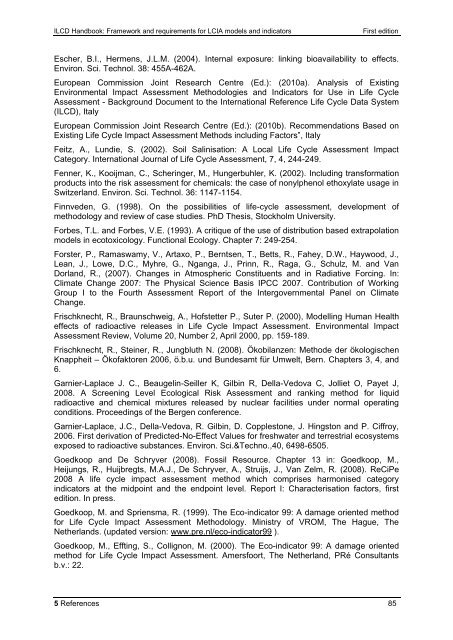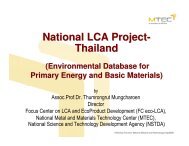ILCD Handbook: Framework and requirements for LCIA models and ...
ILCD Handbook: Framework and requirements for LCIA models and ...
ILCD Handbook: Framework and requirements for LCIA models and ...
Create successful ePaper yourself
Turn your PDF publications into a flip-book with our unique Google optimized e-Paper software.
<strong>ILCD</strong> <strong>H<strong>and</strong>book</strong>: <strong>Framework</strong> <strong>and</strong> <strong>requirements</strong> <strong>for</strong> <strong>LCIA</strong> <strong>models</strong> <strong>and</strong> indicators First edition<br />
Escher, B.I., Hermens, J.L.M. (2004). Internal exposure: linking bioavailability to effects.<br />
Environ. Sci. Technol. 38: 455A-462A.<br />
European Commission Joint Research Centre (Ed.): (2010a). Analysis of Existing<br />
Environmental Impact Assessment Methodologies <strong>and</strong> Indicators <strong>for</strong> Use in Life Cycle<br />
Assessment - Background Document to the International Reference Life Cycle Data System<br />
(<strong>ILCD</strong>), Italy<br />
European Commission Joint Research Centre (Ed.): (2010b). Recommendations Based on<br />
Existing Life Cycle Impact Assessment Methods including Factors‖, Italy<br />
Feitz, A., Lundie, S. (2002). Soil Salinisation: A Local Life Cycle Assessment Impact<br />
Category. International Journal of Life Cycle Assessment, 7, 4, 244-249.<br />
Fenner, K., Kooijman, C., Scheringer, M., Hungerbuhler, K. (2002). Including trans<strong>for</strong>mation<br />
products into the risk assessment <strong>for</strong> chemicals: the case of nonylphenol ethoxylate usage in<br />
Switzerl<strong>and</strong>. Environ. Sci. Technol. 36: 1147-1154.<br />
Finnveden, G. (1998). On the possibilities of life-cycle assessment, development of<br />
methodology <strong>and</strong> review of case studies. PhD Thesis, Stockholm University.<br />
Forbes, T.L. <strong>and</strong> Forbes, V.E. (1993). A critique of the use of distribution based extrapolation<br />
<strong>models</strong> in ecotoxicology. Functional Ecology. Chapter 7: 249-254.<br />
Forster, P., Ramaswamy, V., Artaxo, P., Berntsen, T., Betts, R., Fahey, D.W., Haywood, J.,<br />
Lean, J., Lowe, D.C., Myhre, G., Nganga, J., Prinn, R., Raga, G., Schulz, M. <strong>and</strong> Van<br />
Dorl<strong>and</strong>, R., (2007). Changes in Atmospheric Constituents <strong>and</strong> in Radiative Forcing. In:<br />
Climate Change 2007: The Physical Science Basis IPCC 2007. Contribution of Working<br />
Group I to the Fourth Assessment Report of the Intergovernmental Panel on Climate<br />
Change.<br />
Frischknecht, R., Braunschweig, A., Hofstetter P., Suter P. (2000), Modelling Human Health<br />
effects of radioactive releases in Life Cycle Impact Assessment. Environmental Impact<br />
Assessment Review, Volume 20, Number 2, April 2000, pp. 159-189.<br />
Frischknecht, R., Steiner, R., Jungbluth N. (2008). Ökobilanzen: Methode der ökologischen<br />
Knappheit – Ökofaktoren 2006, ö.b.u. und Bundesamt für Umwelt, Bern. Chapters 3, 4, <strong>and</strong><br />
6.<br />
Garnier-Laplace J. C., Beaugelin-Seiller K, Gilbin R, Della-Vedova C, Jolliet O, Payet J,<br />
2008. A Screening Level Ecological Risk Assessment <strong>and</strong> ranking method <strong>for</strong> liquid<br />
radioactive <strong>and</strong> chemical mixtures released by nuclear facilities under normal operating<br />
conditions. Proceedings of the Bergen conference.<br />
Garnier-Laplace, J.C., Della-Vedova, R. Gilbin, D. Copplestone, J. Hingston <strong>and</strong> P. Ciffroy,<br />
2006. First derivation of Predicted-No-Effect Values <strong>for</strong> freshwater <strong>and</strong> terrestrial ecosystems<br />
exposed to radioactive substances. Environ. Sci.&Techno.,40, 6498-6505.<br />
Goedkoop <strong>and</strong> De Schryver (2008). Fossil Resource. Chapter 13 in: Goedkoop, M.,<br />
Heijungs, R., Huijbregts, M.A.J., De Schryver, A., Struijs, J., Van Zelm, R. (2008). ReCiPe<br />
2008 A life cycle impact assessment method which comprises harmonised category<br />
indicators at the midpoint <strong>and</strong> the endpoint level. Report I: Characterisation factors, first<br />
edition. In press.<br />
Goedkoop, M. <strong>and</strong> Spriensma, R. (1999). The Eco-indicator 99: A damage oriented method<br />
<strong>for</strong> Life Cycle Impact Assessment Methodology. Ministry of VROM, The Hague, The<br />
Netherl<strong>and</strong>s. (updated version: www.pre.nl/eco-indicator99 ).<br />
Goedkoop, M., Effting, S., Collignon, M. (2000). The Eco-indicator 99: A damage oriented<br />
method <strong>for</strong> Life Cycle Impact Assessment. Amersfoort, The Netherl<strong>and</strong>, PRé Consultants<br />
b.v.: 22.<br />
5 References 85



